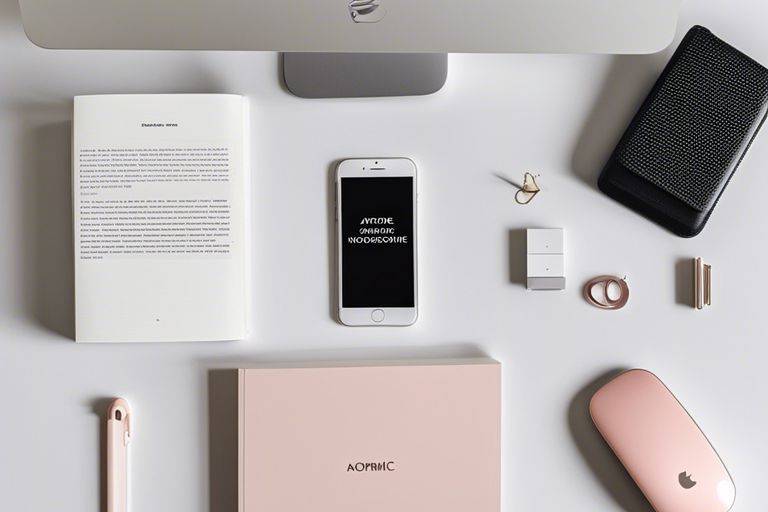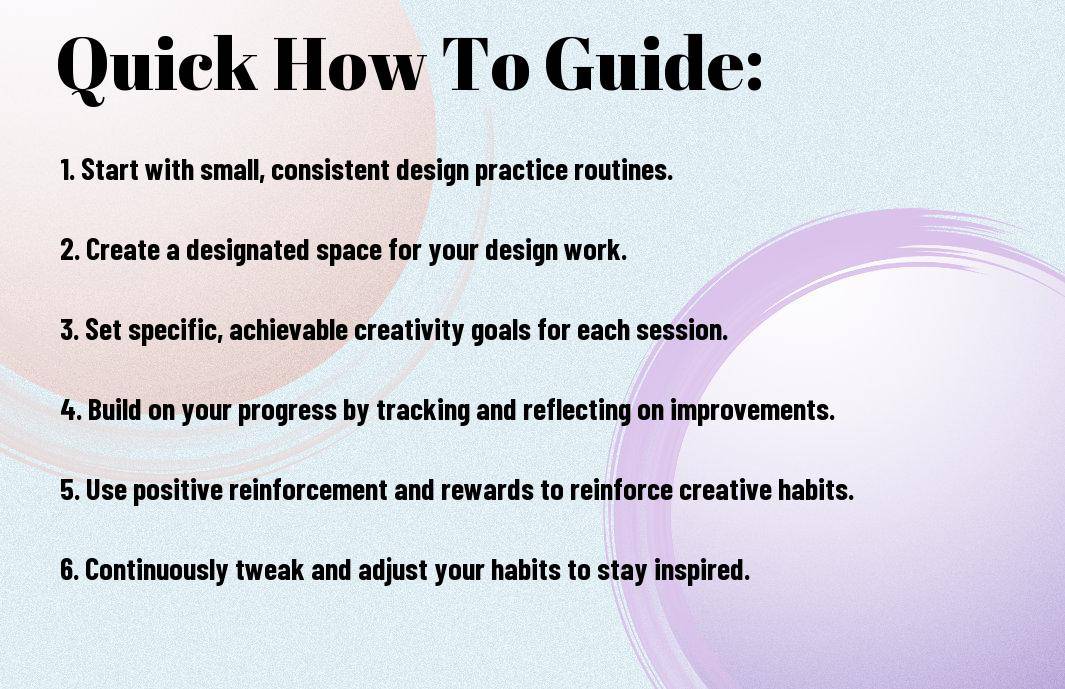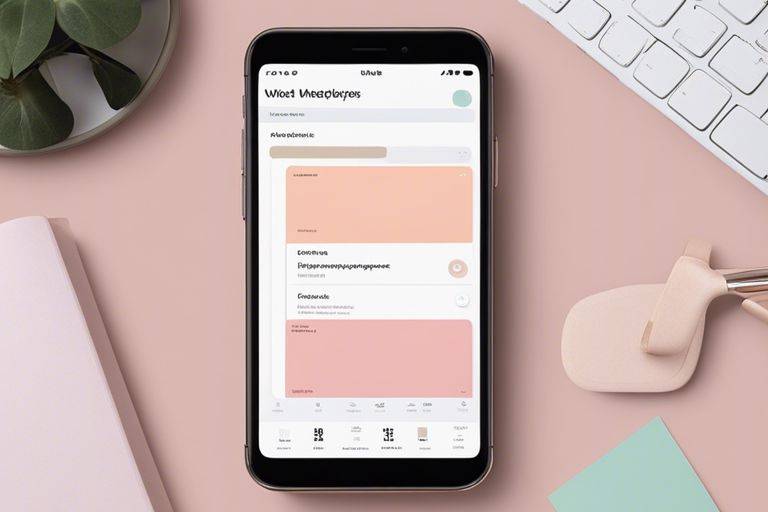
Newsletter Subscribe
Enter your email address below and subscribe to our newsletter

Enter your email address below and subscribe to our newsletter

Atomic Habits for designers! This blog post aims to provide designers with practical tips on how to foster creativity through the implementation of atomic habits. By breaking down the creative process into small, manageable steps, designers can consistently nurture their creativity and produce innovative work. With a focus on habit formation and mindful practice, this guide will help designers unlock their full creative potential.

While making efforts to enhance creativity, designers often struggle to establish sustainable habits that fuel their artistic endeavors. In my blog post “Atomic habits for designers – Lucy Lee”, I examine into the intricacies of forming atomic habits specifically tailored for designers. This article provides actionable insights and practical tips to help designers cultivate habits that nurture their creativity and drive growth in their design careers. For designers looking to boost their creative output and maintain a consistent workflow, implementing an atomic habit framework can be instrumental in achieving sustainable success.
Even the most talented designers can benefit from clarifying their creative goals. Taking the time to reflect on what truly inspires you as a designer and what specific achievements you aim to attain can provide clarity and direction. By identifying your core creative goals, you create a roadmap that guides your daily habits and actions towards fulfilling your artistic vision. Whether it be improving your skills in a certain design tool, exploring a new design style, or launching a personal project, having a clear understanding of your creative objectives is necessary for growth and progress.
While setting ambitious goals is important, breaking them down into smaller, more manageable tasks is key to ensuring consistent progress. By incorporating the principles of atomic habits, designers can transform daunting goals into bite-sized actions that are easier to accomplish. Start by deconstructing your big creative goals into specific, achievable tasks that can be integrated into your daily routine. For example, if your goal is to enhance your illustration skills, committing to sketching for just 10 minutes each day can be a powerful atomic habit that gradually propels you towards mastery. By focusing on small, incremental changes, you lay the foundation for long-term success in your design journey.
Framework: Establishing an atomic habit framework can revolutionize the way designers approach their creative pursuits. By breaking down big goals into manageable tasks and aligning daily habits with core creative objectives, designers can foster a more consistent and productive creative practice. Embracing the concept of atomic habits empowers designers to make meaningful progress towards their artistic aspirations while cultivating a sustainable routine that supports their long-term growth.
Keep creativity flowing by incorporating these tips into your daily routine. Inspiration is a key ingredient for designers looking to create innovative and compelling work. By nurturing your creative spirit, you can unlock new possibilities and push the boundaries of your design practice.
An inspiring workspace can significantly impact your creative output. Surround yourself with elements that motivate and stimulate your imagination, such as art prints, plants, or mood boards. Keep your workspace clutter-free to eliminate distractions and make room for fresh ideas to flourish. The right environment can energize your creativity and keep you inspired throughout your design process.
To maintain a steady stream of ideas, it’s crucial to establish daily routines that nurture your creative flow. Start each day with a creative exercise, such as sketching or free writing, to kickstart your imagination. Take regular breaks to recharge and allow your mind to wander, exploring new sources of inspiration. The key is to cultivate a mindset of curiosity and experimentation, embracing challenges as opportunities for growth.
Creative breakthroughs often come when you least expect them, so stay open to serendipitous moments of insight. By staying curious, consistent, and adaptable, you can keep your creative wellspring flowing and produce work that truly resonates with your audience.
To investigate the world of fostering creativity through atomic habits, it’s vital to understand the power of starting. Every creative journey begins with a single step, and that step is often the most challenging one to take. In his book Minimalist Productivity Guide: Atomic Habits by James Clear, James Clear emphasizes the significance of initiating new habits for long-term success.
One of the biggest obstacles to starting new creative habits is the fear of failure or the unknown. It’s natural to feel hesitant when beginning something unfamiliar, but it’s crucial to remember that progress is made by taking that first step. By acknowledging your fears and embracing the discomfort, you can push through the initial hurdle and pave the way for creative growth.
Whether it’s picking up a new design tool, starting a daily sketching routine, or exploring a different creative medium, the key is to start small and build momentum. Do not forget, progress, not perfection, is the goal.
Habits play a significant role in shaping our daily lives and fostering creativity. To make creative habits irresistible, it’s vital to link them to something enjoyable or rewarding. Whether it’s setting up a cozy corner in your workspace, listening to inspiring music, or rewarding yourself with a treat after a creative session, find ways to associate positive experiences with your creative habits.
Begin by identifying what inspires you and fuels your creativity. Incorporate elements of joy and excitement into your creative routine to make it engaging and fulfilling. The more you enjoy the process, the more likely you are to stick to your creative habits in the long run.
Unlike rigid productivity systems that focus solely on output, fostering creativity requires a different approach. To maintain a steady stream of innovative ideas, designers can benefit from tracking their progress, regaining focus after setbacks, and staying motivated through creative milestones.
Tracking your progress with creative milestones can help you stay motivated and focused on your goals. Setting achievable markers along the way can provide a sense of accomplishment and encouragement as you see your projects come to life. Whether it’s completing a brainstorming session, finishing a prototype, or receiving positive feedback, celebrating these small wins can fuel your creativity and propel you forward.
Even the most seasoned designers experience creative setbacks from time to time. Whether it’s a lack of inspiration, a project that doesn’t go as planned, or a creative block, it’s important to have strategies in place to regain focus and keep your creative momentum going. One effective way to overcome setbacks is to step away from the project momentarily. Taking a break, going for a walk, or engaging in a different creative activity can help clear your mind and spark new ideas.
It is crucial to remember that setbacks are a natural part of the creative process and should not be viewed as failures. By embracing challenges and learning from them, designers can emerge stronger and more resilient in their pursuit of consistent creativity.
After establishing a solid foundation of atomic habits for designers, it’s vital to understand the role of community in fostering creative habits. Being part of a supportive network can significantly impact your creative journey by providing inspiration, feedback, and collaboration opportunities.
For designers, networking and collaborating with other creatives can serve as powerful habit catalysts. Surrounding yourself with like-minded individuals can spark new ideas, offer different perspectives, and motivate you to push your creative boundaries. Through collaboration, you can leverage the strengths of others and overcome creative blocks more effectively.
For designers looking to refine their creative habits, seeking and providing feedback is crucial. Constructive criticism from peers can help you identify areas for improvement, refine your design skills, and increase your creative confidence. Additionally, offering feedback to others allows you to deepen your understanding of design principles and build stronger relationships within the design community.
Fostering creative habits through feedback is a two-way street that can lead to continuous growth and learning opportunities for designers.
Developing healthy creative habits is vital for designers to sustain productivity and innovation in their work. By fostering a supportive community, seeking collaboration, and actively engaging in feedback processes, designers can cultivate a creative environment that nurtures their professional growth and artistic development.
All designers strive to find the perfect balance between productivity and creativity. This delicate equilibrium can be challenging to maintain, but understanding the key factors can help you navigate this terrain more effectively. Some crucial considerations include setting clear goals, creating a structured routine, carving out designated creative time, and allowing for spontaneity within that framework. This approach can help you stay on track while also fostering the freedom necessary for innovative thinking.
On your creative journey, recognizing the importance of fluidity within structure can unlock a wealth of ideas. It is vital to allow room for experimentation, play, and shifting perspectives. By integrating pauses for reflection and exploration into your workflow, you can enhance your creative output and prevent burnout.

Many designers are constantly seeking ways to boost their creative process and productivity. In today’s digital age, technology offers a myriad of resources to help designers foster and enhance their creativity in remarkable ways. By harnessing the power of various apps and tools, designers can streamline their workflow, stay organized, and spark fresh ideas.
With the abundance of design software available, designers can leverage platforms like Adobe Creative Suite, Sketch, or Figma to bring their creative visions to life. Project management tools such as Trello or Asana can aid in organizing tasks and deadlines, ensuring efficiency in the creative process. Additionally, creativity-boosting apps like Procreate or Canva can help designers explore new techniques and design styles, fostering innovation in their work.
If you find yourself constantly battling digital distractions that hinder your creative flow, consider implementing strategies to minimize interruptions. Tools like website blockers, such as StayFocusd or Freedom, can help limit time spent on non-important websites. Creating a designated workspace free from distractions and establishing a daily routine can also enhance focus and productivity. Keep in mind, a focused mind is key to unlocking your full creative potential.
Plus, setting specific time blocks for focused work, incorporating regular breaks to recharge, and practicing mindfulness techniques can significantly improve your ability to concentrate and stay engaged in your creative process.
Ultimately, by implementing atomic habits, designers can nurture their creativity and build a foundation for sustained innovation. Fostering good habits like setting a daily creative routine, seeking inspiration from diverse sources, and iterating through constant experimentation can significantly impact their design process and outcomes. To examine deeper into the power of habits, check out the Habits Guide: How to Build Good Habits and Break Bad Ones.
A: Fostering creativity is crucial for designers because it allows them to come up with innovative solutions, think outside the box, and create unique designs that stand out.
A: Atomic habits can help designers in fostering creativity by breaking down the creative process into small, manageable tasks that can be consistently worked on to build momentum and improve creative thinking.
A: Some atomic habits designers can adopt include setting aside dedicated time for creative work, practicing daily brainstorming exercises, seeking inspiration from different sources, and experimenting with new techniques and tools.
A: Designers can create a conducive environment for fostering creativity by organizing their workspace, surrounding themselves with inspirational materials, setting clear goals, and minimizing distractions.
A: Designers can overcome creative blocks by taking breaks, engaging in activities outside of design, collaborating with other creatives, seeking feedback, and trying new approaches to stimulate fresh ideas.
A: The timeline for seeing improvements in creativity by practicing atomic habits can vary for each designer. However, consistent practice of atomic habits over time can lead to noticeable improvements in creativity and design skills.
A: Yes, designers can combine atomic habits with other creative techniques such as mind mapping, mood boards, design thinking, and creative exercises to enhance their creative process and further stimulate innovation and originality in their designs.
The One Thing – Gary Keller and Jay Papasan’s Focus on Making Everything Else Easier
Eisenhower Matrix – Dwight D. Eisenhower’s Strategy to Prioritize Tasks by Urgency and Importance
Study Routines Transformed: Unleash Atomic Habits for Students to Boost Your Studies
The 10-Minute Rule – A Method to Overcome Procrastination by Starting Small